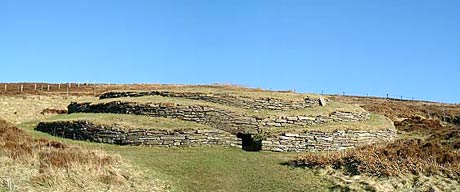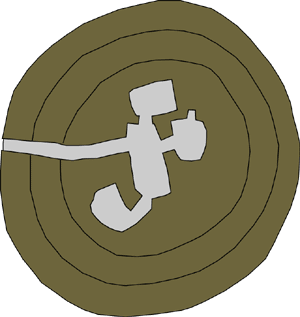
 |
 |
| Home |
| About Orkney |
| History |
| Tradition |
| Folklore |
| Placenames |
| Images |
| Downloads |
| About the Site |
| Contact |
| Links |
| Search Site |
| Awards |
| The Wideford Hill Cairn | |
|
Built into the north-western slope of Wideford Hill, a few miles from Kirkwall, is the Wideford Cairn. Around 328 feet above sea-level, this prehistoric structure is a Maeshowe-type cairn dating from around 3,000 BC. Built on a steep hillside over looking the Bay o' Firth, the cairn's builders quarried into the slope to create a level platform on which to build their monument. Unlike most other cairns in Orkney, Wideford's exterior stonework is visible today, lending the structure a "stepped" appearance, made up of three concentric rings. The cairn's earthen covering was removed after the monument was taken into state care, in the 1900s, but originally it probably looked like a domed mound within a retaining wall.
Inside the cairn, three small side cells branch off from the main rectangular chamber, which is about five feet wide and ten feet long at floor level, but much narrower at head height. The side chambers are then built into the north, east and south walls. During the 1849 excavation, no recognisable human remains were found, only a quantity of animal bones (cow, horse, boar, sheep and deer) among the rubble filling the main chamber. There were no traces of pottery either, which, coupled with the absence of remains, seems to indicate that the cairn had fallen out of regular use before it was finally sealed. The final ritual act surrounding the tomb was its deliberate filling with debris. When the cairn was opened in 1849, the main chamber was found to be almost entirely full of rubble. The height of this rubble was above the level of the entrance passage which seemed to indicate that the material had been thrown into the chamber from the roof. Closer investigation revealed a chimney-like structure that may have been built solely for this purpose. Communing with the spirits of the dead?
Along with the theory that these slots allowed light to enter the chambers at specific times of the year, it has also been suggested that they may have been used for offerings of some sort. Perhaps most interesting of all is the idea that the slots allowed the living, who undoubtedly participated in some form of ancestor worship, to converse with the spirits of the dead. An intriguing theory is that the narrow slot could been used as some form of an oracle. People might seek the advice of the ancients by asking their questions through the slot - the echoes of their distorted words coming back as an answer could then be interpreted as they wished. If this is the case, could the chimney-structure in the chamber roof, although definitely used to fill in the chamber at a later date, have had an earlier purpose? For more information about theories relating to acoustics and the design of chambered cairns, click here. |
The Wideford Cairn faces west and as such is bathed in the light of the setting sun from the end of February. What the significance of this, if it is significant at all, is lost. The entrance to the cairn is very low and small, unlike Maeshowe's grand entrance to welcome the light of the midwinter sunset. A few miles to the west, and facing the Wideford Hill tomb, is the Cuween Hill cairn. Where animal remains are found within the rubble within a tomb, it is generally thought that these represented the remains of a ritual funeral feast consumed by the living or perhaps an offering for the dead. Recent excavations, however, have cast some doubt one this, suggesting that some remains may belong to animals who had made their own way into the cairns. The name "Wideford" — the name of the hill on which the cairn stands — probably derives from the Norse "vide-fjord" referring to the hill's proximity to the stretch of sea known as the Wide Firth. However, an interesting theory may point to its role as one of a network of beacon hills, on top of which warning fires were lit. Across Orkney, most of the hills on which these warning fires were lit have taken the name "Ward" or "Wart" - deriving from the Old Norse word "varš" meaning beacon". Another element used to describe the site of warning beacons is "vita", found these days in places such as Fitty Hill on Westray. It has been therefore been suggested that name "Wideford" could actually be a corruption of both these elements - "vita-varš" making Wideford Hill the "Beacon Hill". |

 These days access to the chamber is through the
roof, the original western entrance being 17.4 feet long and less
than two feet high and wide.
These days access to the chamber is through the
roof, the original western entrance being 17.4 feet long and less
than two feet high and wide.